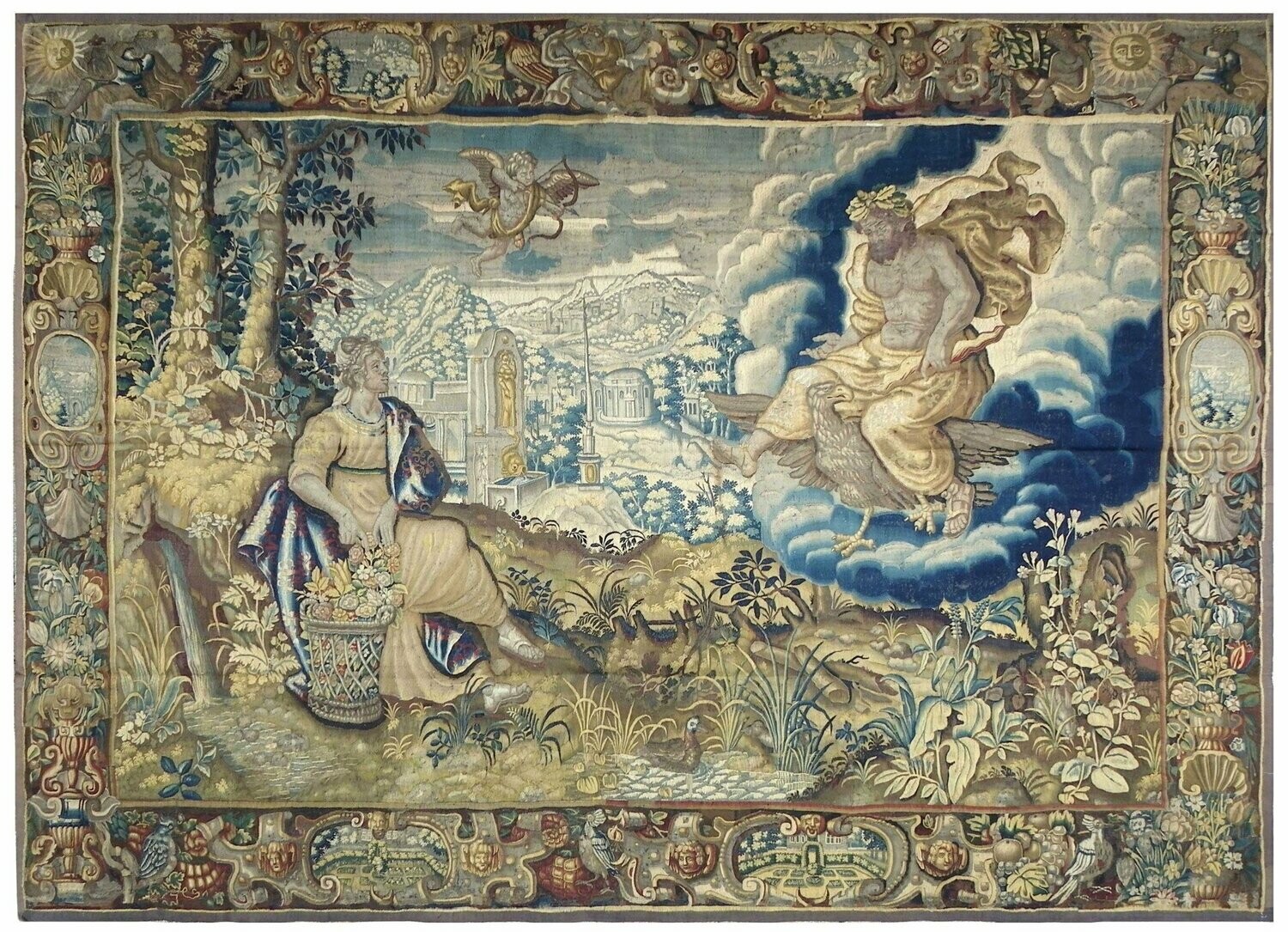COLLECTION
Tapestry of Flanders - 17th century period-Zeus - Dim:4.20Wx3.20H
€0.00
In stock: 1 available
Product Details
Reference number :78J/ 2788
Origin : Flanders
Period : th century
Provenance: Private Collection
Composition: Wool and silk
Dimension: 4.20 L x 3.20 H
The god Zeus
symbolized by the eagle is seducing a young woman, in the presence of Eros, god of love, who is about to throw an arrow to symbolize this budding love. The fact that the young woman in front of him is holding a basket full of flowers/fruits evoking a horn of plenty, may suggest that it is the goddess Hera.
God of Heaven and ruler of the gods of Olympus. Zeus corresponds to the Roman god Jupiter.
Homer regarded Zeus as the father of gods and mortals. He had created neither gods nor mortals, he was the protector and ruler of both the family of Olympus and the human race. He was the lord of the sky, responsible for its storms and rains.
Zeus
ruled the gods on Mount Olympus in Thessaly. His main temples were in Dodona, in Epirus, land of oaks and its oldest altar, famous for its oracle, and in Olympia, where the Olympic Games were celebrated in his honour every four years.
Zeus was the youngest son of the Titans, Cronos and Rhea, and the brother of the deities Poseidon, Hades, Hestia, Demeter and Hera.
According to one of the ancient myths about the birth of Zeus, Cronus, fearing that he would be dethroned by one of his children, swallowed them at birth. Zeus was saved by his mother Rhea who hid him in Crete, where he was raised by the nymph (or goat) Amalthea who fed him with her milk.
It was told that when this goat died, Zeus took its skin as armour: it was the aegis, whose power he felt the first time, during the fight against the Titans...
Hera
is the greatest of the Olympian goddesses. She is the daughter of Cronos and Rhea, and therefore the sister of Zeus. Like all her brothers and sisters, except Zeus, she was swallowed up by Cronos but brought back to life by the cunning of the half-breed and the strength of Zeus.
Hera, it was said, had been brought up to the ends of the world by Ocean and Thethys, to whom Rhea had entrusted her during the struggle between Zeus and the Titans. She had kept a great gratitude to them, and later on, when Ocean and Thethys fell out, she sought to reconcile them.
Then Hera married Zeus in a solemn wedding. She was, said Hesiod, the third woman that the god took in a "just marriage". The first was a half-breed; then came Themis. It was said, however, that the love of Zeus and Hera was very old, and that they had secretly united at the time when Cronos still reigned over the universe and before the war against the Titans.
As the legitimate wife of the first among the gods, Hera is the protector of wives. She is portrayed as jealous, violent and vindictive. She is often irritated against Zeus, whose infidelities are insults to her. She pursues with her hatred not only Zeus' lovers, but also the children he gives them.
Hera intervenes in a great number of legends: she persecutes Io and suggests to the Curetes to make Epaphos, the son of her rival, disappear. She is at the origin of Semele's tragic destiny. She strikes Athamas and Ino with madness, to punish them for having raised little Dionysus, the illegitimate son of Zeus and Semelele. She advises Artemis to kill Callisto, whom Zeus had seduced. She tries to prevent the birth of Leto, and the birth of Artemis and Apollo, and so on.
Zeus is obliged to rely on her. Several times, he tries to hide his children, to remove them from the wrath of Hera. For example, he locks Elara under the earth, and it is there that she gives birth to Tityos. He also resorts to other tricks, turning Dionysus into a goat, for example.
Hera took part in the fight against the Giants. She was attacked by Porphyrion, who had a violent desire for her. While the Giant was tearing the dress of the goddess, Zeus struck him with lightning and Heracles finished him with an arrow. Likewise, Hera was attacked again, later by Ixion, who wished to unite with her. But Zeus fashioned a cloud that deceived Ixion, and Hera was saved. Hera still appears to be the protector of the ship Argo, which she helped to cross the rocks of Cyanea and the passes of Charybdis and Scylla.
Our house assures you the sale of a tapestry with invoice and approved expertise, well cleaned, in good condition with its fixing system. If it should be necessary, we will specify the work that has been done. All our tapestries can be presented to you at your home in France and neighbouring countries before your final decision.
Save this product for later
Display prices in:
EUR
Tapisserie Aubusson Verdure Ancienne Tapis Contemporain Coussin Tapis COLLECTION TAPISSERIE ANCIENNE TAPISSERIE CONTEMPORAINE COUSSIN TAPISSERIE ORIENT TAPIS PERSE TAPIS IRAN Achat Vente tapisserie anciennes à paris. Tapisserie Aubusson Ancienne, Tapisserie Bruxelles, Tapisserie Flandres, Coussin en Tapisserie
Nos horaires d'ouverture :
lundi-Jeudi-Vendredi 9h-19h
Tous droits réservés |
GALERIE JABERT
© 2025
Contact :
Tél : +33 - 01 43 06 45 55
Adresse :
78, Avenue Suffren - 75015-Paris
Centre des Antiquaires Village Suisse,
Allée centrale, boutique N° 91-92
4, Grande Rue 23200-Aubusson
(sur rendez-vous)
e-mail :
Contact@galeriejabert.com
Newsletter
Restez au courant grâce à notre newsletter et recevez toutes les nouveautés de notre entreprise en exclusivité !
S’inscrire à Newsletter
S’inscrire à Newsletter



